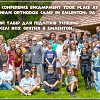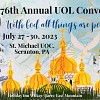SAINT SOPHIA
UKRAINIAN ORTHODOX THEOLOGICL SEMINARY
PRESS RELEASE
Annual Pysanka Workshop at Saint Sophia Seminary
As Great Lent was coming to a close and Pascha quickly approaching, local young adults met at Saint Sophia Ukrainian Orthodox Theological Seminary on Monday evening to continue the Ukrainian springtime tradition of creating beautiful pysanky. The workshop was sponsored by the newly established Ukrainian Orthodox League (UOL) Chapter of Saint Sophia Seminary (the chapter was established this past year) and was led by Dobrodijka Oksana Pasakas and Mykola (Kolya) Hlushko. Participants learned about the history and the technique used to create these delicate eggs.
The practice of creating pysanky began as a pagan springtime ritual, continued after the baptism of Kyivan-Rus in 988 and has continued to be made by Ukrainians and Ukrainians living in the diaspora. The practice may have not changed over the years, but the symbolism has changed over the years. Many of the symbols depicted on the eggs have taken on religious meanings, reflecting the current religious beliefs of the Ukrainian people. The tradition, along with its symbolism and method of wax-resist application, has been passed on from generation to generation to the present day when Ukrainians create these eggs in the weeks leading up to Pascha in order to give away the decorated eggs to loved ones and friends or to include them in their traditional Pascha baskets next to the meats and cheeses to be blessed after Liturgy.
After the short presentation on the history and method of creating a pysanka, the participants quickly grabbed all the necessary supplies—a clean white egg, a kistka (a special stylus), wax, and a candle—selected or imagined their own design to apply to the egg and set off to start the process. As the first lines in wax were drawn on the eggs, the room suddenly got silent as everyone began to concentrate on their designs. It wasn’t until the first set of eggs were submerged into the first jars of dye, usually into the yellow or orange shades which are the lightest of the colors, did the participants begin to admire and compare each other’s designs.
First time pysanka student, Fr. Yurij Mulyarchuk recounted his experience during the class: “This was my first time in my life that I made a pysanka. I was afraid at the beginning how my egg would turn out but then at the end I was surprised how my pysanka turned out-I was very glad and happy. I hope to make another one next year.” Several of the workshop participants had attended the previous workshops and were ready to jump right back in and learn something new.
Seminarian Volodymyr Yavorksyi commented on his second experience making pysanky: “During the class, I learned how to make a pysanka. The class was very interesting for me. This year I made a better pysanka than last year. Hope that next year, my pysanka will be even better. With every year, I gain more experience.” Keeping the tradition and practices of the Ukrainian people alive is at utmost importance for some students—especially during the recent events taking place in Ukraine.
Subdeacon Ivan Chopko enjoyed Monday’s class on pysanky, even though it was four hours long, because it reminded him of his childhood and the importance of Ukrainian culture.
The history, tradition and symbolism of the pysanka have survived several centuries—and will continue into the future as long as there are people who cherish and uphold these Ukrainian traditions.
Missed this year’s workshop? Join us next year when we continue the tradition and make more pysanky!
By Dobrodijka Oksana Pasakas
Photos by the Seminarians
|
| |||||||||||||







